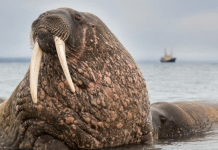Yes, female walruses do have tusks however, unlike male’s tusks the female’s tusks are probably shorter and slightly thinner too. Males usually use their tusks to show dominance within the group—something that females aren’t supposed to do that. Nevertheless, females use their tusks to climb out of the water as well as to defend themselves against the Arctic’s predators.
Tusks are actually long canines that grow up to 3 feet in length and weighs up to 12 pounds. Females rarely use their tusks in fighting. They are thought to dig holes in the ice using their tusks.








